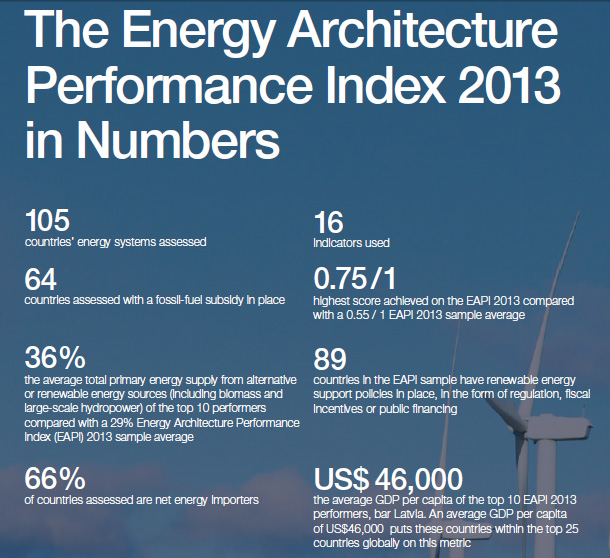A new energy report by the World Economic Forum, and produced in collaboration with global management consultancy Accenture, highlights that high-income countries are leading the transition to a new energy architecture but still have work to do on environmental sustainability.
The Global Energy Architecture Performance Index Report 2013 measures the strengths and weaknesses of countries’ energy systems from an integrated economic, environmental and energy security perspective, and is also designed to help countries manage and navigate the challenges that arise from this period of change which, according to the International Energy Agency (IEA), will require US$ 38 trillion of investment in energy supply infrastructure by 2035 to meet rising global demand. The findings reveal that high-income countries have proven best at managing the transition to a new energy architecture. Norway ranks in first place in the index, where a strong energy policy coupled with multiple energy resources has delivered cheap, plentiful and relatively clean power and generated large national revenues. With seven other European countries joining Norway in the top 10, the list is completed by New Zealand (5) and Colombia (6). No OPEC country features in the top 50, while the USA ranks 55th. Of the BRICS, Brazil leads in 21st place, followed by the Russian Federation (27), South Africa (59), India (62) and China (74). Tunisia is the highest ranked Arab country on the index, followed by Algeria, Libya, Egypt, Oman, Saudi Arabia and the UAE. According to Omar Boulos, Managing Director of Accenture, Middle East, the index is a global benchmark for the Middle East region to aim for, and many Gulf countries are already taking positive and ambitious steps to address their future energy needs. “Whilst the Middle East countries did not rank highly in this report, I expect this to change in future index reports. Governments and private companies across the region are investing billions of dollars in energy infrastructure and they have declared very real commitments to addressing the challenges of energy supply, particularly in terms of renewable energy,” said Boulos. “For example, Masdar’s 100MW Shams 1 CSP plant in Abu Dhabi is due to open this month, and plans are underway for the Sheikh Mohammed bin Rashid Al Maktoum Solar Park in Dubai. In Saudi Arabia, the government recently announced it would invest $109 billion to install 41GW of solar and 9 GW of wind capacity by 2032.” “At last month’s World Future Energy Summit in Abu Dhabi, there were over 30 renewable energy projects worth $8 billion seeking funding, including a $300,000 250KW solar project in the UAE and a $280 million 65-130MW solar project in Jordan,” said Boulos. “Combine these projects with a $50 million funding cycle for clean energy projects announced by the Abu Dhabi-based International Renewable Energy Agency in conjunction with the Abu Dhabi Fund for Development, and you can see that energy architecture in the Middle East is rapidly evolving.” “It is extremely encouraging to see a region that is so reliant on fossil fuels for their income take such affirmative action to join the global community’s collective response to the challenges of high energy demand. This index, which Accenture helped to produce, clearly shows the benchmark standards that countries in the Middle East need to achieve,” said Boulos. The Global Energy Architecture Performance Index Report 2013 identifies that many developing countries still struggle to supply citizens with basic energy needs, with 12 per cent of countries analyses providing electricity to less than 50 per cent of their total population. The report also considers how issues around fossil-fuel subsidy, water use for energy production and effective management of resource wealth need addressing globally. “The scale and complexity of the global energy industry demands a country-by-country approach to managing change,” said Arthur Hanna, Senior Managing Director, Energy Industry, Accenture, and a Member of the World Economic Forum’s Global Agenda Council on New Energy Architecture. “The Energy Architecture Performance Index helps nations take stock of their energy architecture challenges and identify specific focus areas coupled with best-in-class examples to use when managing their transition.”
“Energy decisions can be simplified through a common understanding of the trade-offs they require,” explained Roberto Bocca, Senior Director, Head of Energy Industries, World Economic Forum. “With clear objectives to achieve a balanced energy system that is environmentally sustainable, drives the economy and is secure, decision-makers should facilitate quicker and more cost effective transitions. The index is a tool to help in this process.” Omar Boulos says Accenture’s work in helping the World Economic Forum to produce this landmark report demonstrates the company’s global expertise and experience in the energy sector. “Accenture has proven credentials in helping both governments and the private sector to implement their energy architecture plans. For example, we are currently providing change management and communication support to the Saudi Electricity Company as it moves towards privatization as part of a corporate restructure,” said Boulos. “With GCC countries like Saudi Arabia, Kuwait, Oman, Qatar and the UAE all announcing achievable targets to produce energy from sustainable sources, the level of activity in the energy sector will continue to grow, and Accenture is ready to provide its expertise to assist in this transitional process.”

MOST POPULAR IN LAST 24 HRS
MOST POPULAR IN LAST 7 DAYS
|